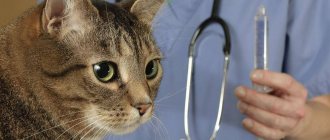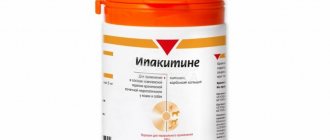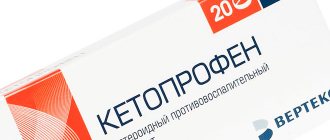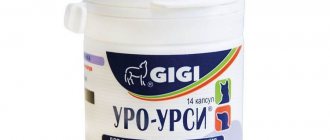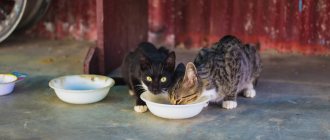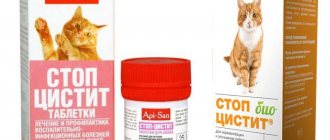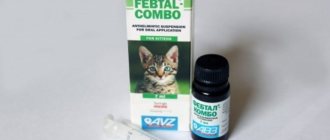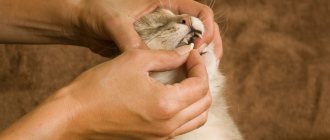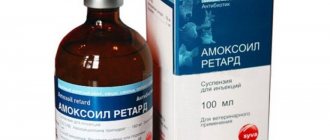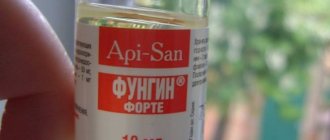For severe vomiting in pets, the human drug Cerucal is used. This is the best antiemetic option for dogs and cats. The medicine has a mild effect, is well tolerated and is highly effective. The article will discuss the features of using "Cerucal" for dogs and cats , methods for calculating the dosage for animals and contraindications, in the presence of which taking the medication is strictly prohibited.
"Cerucal" for dogs and cats
Description
Ranitidine is one of the most popular antiulcer drugs and is successfully used in veterinary medicine to treat cats and dogs. It is part of a group of substances that block histamine receptors. Its action reduces the rate of gastric juice production, decreases acidity, and as a result, the digestion process is normalized.
Under the influence of Ranitidine, the total volume of secretion also decreases. This creates favorable conditions for the regeneration of muscles in the walls of the stomach and duodenum damaged by peptic ulcer. The blood supply to organs improves, and the secretion of mucus, which performs protective functions, increases. The main active ingredient of the drug is ranitidine hydrochloride. Ranitidine for cats is used along with Cimetidine and Famotidine, which are analogues in their action.
Ranitidine is produced in two types: injection solution and tablets for oral use.
.
Description of the drug Sereniya
The veterinary drug Cerenia was developed by the American pharmaceutical corporation Pfizer, Inc., one of the largest in the world, and is produced by Pfizer PGM, the French division of the company. Sereniya is an exclusive antiemetic used for cats and dogs and is available in two dosage forms: injectable and tablet.
Injection solution
Sereniya injection solution looks like a clear, yellowish liquid and is sold in glass bottles of 20 milliliters. Serenia is not packaged in containers of other sizes. Each bottle must be packed in a cardboard box, accompanied by comprehensive instructions and marked with information about the manufacturer, release date and other data.
When purchasing, be sure to check the tightness of the drug - glass vials with the solution are tightly sealed with rubber stoppers, over which they are rolled with aluminum caps for reliability.
Compound
The active ingredient of Serenia is maropitant; the solution also contains auxiliary ingredients:
- sodium β-cyclodextrin sulfobutyl ether;
- metacresol;
- purified water.
Maropitant is 10 mg/ml in the Serenia formula
Storage conditions
If stored correctly, the drug can be used for three years from the date of manufacture. But if you open the bottle, then its contents will have to be used promptly - within four weeks. After this period, the remaining solution will need to be poured out, and the empty bottle will need to be thrown away; it cannot be used for any household purposes.
Sereniya, like most pharmaceutical drugs, should be stored in a dry place, separate from food and feed products at a temperature not exceeding 30 degrees. You can’t freeze Serenia, otherwise it will lose its medicinal properties.
Serenia solution must remain transparent and homogeneous
A solution that for any reason has lost transparency, is cloudy, has sediment or any foreign inclusions, should not be used and must be disposed of.
Pills
The tablet form of Serenia is marketed as an antiemetic for dogs, but veterinarians often prescribe this type of drug for cats . It should be noted that of the four types of tablets offered by the manufacturer, differing in the concentration of maropitant, only two are suitable for cats, with the lowest content of the active ingredient: 16 or 24 milligrams.
Serenia for dogs is available in four tablet versions
These pills weigh 100 and 150 milligrams, respectively, and are packaged in cardboard boxes with a green or lilac background. Each package contains a blister with four yellowish tablets, appropriately marked, as well as detailed instructions. The tablets are oval in shape and divided in half by a transverse line, which helps to accurately adhere to the dosage of the drug when used. In addition, on one side of each tablet there is an inscription indicating the concentration of the active substance.
Indications for use
The main indication for prescribing Ranitidine tablets to cats is the need to reduce the acidity of the environment in the stomach for various diseases of the digestive system and for their prevention:
- Ulcers of the stomach and duodenum, provoked by prolonged treatment with medications to combat inflammatory processes.
- For therapeutic and prophylactic purposes in case of exacerbations of peptic ulcers of the digestive system.
- For course treatment of gastritis.
- During rehabilitation in postoperative periods.
- To prevent recurrent effects of bleeding in the stomach or esophagus.
Instructions for use of Ranitidine for cats prescribe the use of an injection solution in the same cases as tablets, including the following:
- duodenal ulcer of infectious bacterial origin;
- prevention of aspiration of gastric juice during surgical operations using anesthesia.
Application procedure
The dosage is determined by the veterinarian, taking into account the clinical picture of the disease and the individual characteristics of the cat.
When prescribing a tablet form of the drug, the dosage of Ranitidine for a cat is 1-3 mg per 1 kg of animal weight. Take orally twice daily.
Injection solution. The dose for cats is 1-2 mg per 1 kg of animal weight. It is administered intravenously or intramuscularly, 2 times a day. The solution is administered slowly, the rate of administration is indicated by the doctor.
The drug is discontinued gradually to avoid shock.
Instructions for use and dosage
Calculating the dosage is quite simple, you just need to weigh your pet first. One tablet weighing 0.3 g is designed for 3 kg of cat.
It turns out that for 1 kg of cat weight there is 0.1 g of medicine. If your pet is still very small, and you can’t exactly split the tablet evenly, then grind the tablet into powder, add three milliliters of water and stir. The result is a liquid solution of the drug, which is quite easy to measure with a syringe. With its help, you can pour diluted medicine into the animal’s mouth.
The medicine is given to the cat once, preferably in the morning, before or during feeding. By the way, the tablet does not have a strong smell or taste, so you can safely mix it with food. Usually cats, unsuspectingly, eat it with breakfast.
As already mentioned, in most cases, dead parasites are eliminated from the body on their own. But if the cat had a high degree of helminthic infestation, then it is better to prescribe her a laxative so that the parasites leave the body more quickly and do not cause harm. Also, in case of extensive infection, the medication should be repeated after 10 days.
This drug is also used for prevention - four times a year. Prevention should be carried out not only for animals that visit the street, but also for pets. Parasites can enter their body through food, from the shoes of household members, or in another way.
Overdose
If the dosage prescribed in the instructions is exceeded, the animal may experience convulsions and disturbances in the rhythm of the heartbeat. Treatment in such cases is symptomatic.
chPRTPU # 10967 (16.03.2005 13:15)
ъДТБЧУФЧХХКФЭ! NPK ChPRTPU VShchM 10920. chETPSFOP, S OERTBCHYMSHOP CHSTBIMBUSH. NPA UPVBLKH OE TCHEF RPUME EDSH, RTPUFP RPUME LBTSDPZP RTYENB RAY KH OEZP PFTSCHLB. rTY OEK OYUEZP OE CHSHCHIPDYF, RTPUFP TSCHZBEF. uPVBLE ZPD Y 2 NEUSGB, FBLUB. vKhDH VMBZPDBTOB ЪB PFCHEF.
pFCHEF:
chPRTPU # 10968 (16.03.2005 13:16)
x NEOS RKhDEMSH UTEDOYK EK 3 ZPDB RPUME FEYULY RTPYMP 2 NEUSGB OBYUBMB RPULHMYCHBFSH YEEF KHLTPNOPE NEUFP RPSCHYMBUSH NPMPLP LFP HCE CHFPTPK UMKHYUBK YUETE OELPFPTPPE CHTENS CHUE RT PIPDYF NPTsEF X OEЈ MPTSOBS VETENEOOPUFSH
pFCHEF:
ULPTEE CHUEZP X hBYEK UPVBLY MPTSOBS EEOOPUFSH. pZTBOYUSHFE UPVBLH CH CHPDE, CH VEMLPCHPK RYEE, NPTsOP DBChBFSH OENOPZP UHIPZP LPTNB, VPMSHYE ZHMSFSH U UPVBLPK.
chPRTPU # 10969 (16.03.2005 13:28)
LBL Y YUEN LPTNYFSH RPMHZPDPCHBMPZP EEOLB
pFCHEF:
lPTNYFSH EEOLB OHTSOP 3-4 TBBB CH DEOSH TBOPPVTBOPK RYEEK (ZPCHSDYOB, RFYGB, LTHRSCH, PCHPEY, OETsYTOSHCH LYUMP-NPMPYUOSCH RTDPDHLFSCH) Y PVSBBFEMSHOP LPNRMELUOSCH CHYFBNYOOOP -NYOETBMSHOSHE DPVBCHLY.
chPRTPU # 10970 (16.03.2005 13:52)
ъДТБЧУФЧХХКФЭ! x NEOS RILYOU 3.5NEUSGB X OEZP ABOUT ZMBBI RPSCHMSAFUS LBL RMEOPYULY. lPZDB S RTPNSCHCHBA ENKH ZMBYUB YUBEN POY UNSHCHBAFSHUS OP ABOUT UMEDHAEYK DEOSH YMY YUETE DEOSH RPSCHMSAFUS UOPCHB RTYUEN VSHCHBEF ABOUT PDOPN OTBULE EUFSH ABOUT DTHZPN OEF. rPDULBTSYFE RPTsBMHKUFB SFP LFP Y SFP DEMBFSH. URBUYVP. aboutBFBYB
pFCHEF:
zMBЪB CHUEZDB OHTsOP UNPFTEFSH, CHPNPTSOP, YuFP X UPVBLY LPOSHALFYCHYF, RPRBDBOYE TEUOIG CH ZMBY FTBCHNBFYBGYS ZMBB. rTPNSCHCHBFSH ZMBЪB MHYUYE TBUFCHPTPN ZHTBGYMYOB. rPLBTSYFE UPVBLH CHEFETYOBTH. EUMY CHCH NPULCHE, FP NPTSEFE PVTBFYFSHUS CH OBYKH LMYOILKH, CHUE CHPRPTUSCH RP F.688-4185.
chPRTPU # 10971 (03/17/2005 12:16)
dPVOSHK DEOSH! nPEK Lpyle vBZYTE 1 ZPD - CH FEUEOY OEDEMY EE OULPMSHLP TB CHSHCHTCHBMP RPUME RTYCHSHYUOPK EDSH - UBNP EE RPchedeoye OE Y'NEOYMPUSH - S EE RPFPN OE LPTNYMB, FPMSHLP DBCHBMB RYFSH B UE ZPDOS KhFTPN POB RPLKHYBMB PVEЪTSYTEOOOSCHK KPZHTF UBNB S RPEIBFSH CH LMYOILKH OE NPZH - NPTsEF CHTBYu RPNPYUSH ABOUT DPNH - YMY LFP OE FBL UFTBYOP - POB UPVYTBEF RP DPNH CHUE!! — DBCE ЪBOSHLBMB Y ЪBZMPFYMB PUFBFLY ChPЪDKHYOPZP YBTYLB
pFCHEF:
nPTsOP RTEDRPMPTSYFSH, YuFP X LPILY YMY YUFP-FP YOPTDOPE CH TSEMHDLE YMY LYYEYUOYLE, YMY PFTBCHMEOYE. PLBUBFSH RETCHHA RPNPESH Y PUNPFTEFSH LPYLKH NPTsOP Y ABOUT DPNKH. EUMY CHSHCH YJ NPULCSHCH, FP NPTSEFE ЪBDBFSH DPRPMOYFEMSHOSHCHPRTPUSH YMY CHSHCHBFSH CHEFETYOBTB ABOUT DPN RP F.688-4185.
chPRTPU # 10972 (17.03.2005 13:08)
ъДТБЧУФЧХХКФЭ! OBYB LPYLB TPDYMB PDOPZP LPFEOLB. YuFP DEMBFSH DBMSHYE OE FUCK?
pFCHEF:
chPRTPU # 10973 (17.03.2005 13:09)
ъДТБЧУФЧХХКФЭ! URBUYVP ЪB RPNPESH! nPENH EEOLH 1.5 NEU. lPTNYFSH TEYMYMY PVSHYUOPK RYEEK. dBA LBYKH ZTEYUOECHHA, TYUPCHHA Y DPVBCHMSA LHTPYULH, YODEKLH. dBA LIE Y FChPTPTsPL. yuETEDHA, LPTNMA 5-6 TB CH DEOSH. dPUFBFPYuOP MY CH FBLPN TBGYPOE CHYFBNYOPCH YMY OHTSOP EEE YuFP-FP DBCHBFSH, NPTsEF LBLYE-OYVKhDSH CHYFBNYOSCH PFDEMSHOSH? rTPDBCHEG ULBUBMB, YuFP LPTNYMY LBIBNY Y UKHIYN LPTNPN. nPTsOP UPCHNEEBFSH UHIPK LPTN U OPTNBMSHOPK RYEEK? EEOPL KH OBU KHCE 5-SCHEK DEOSH Y UPCHUEN OE RSHEF CHPDH. with DPVBCHMSA LYRSUEOHA CHPDH CH LBIKH. rTBCHYMSHOP MY LFP? rYUBEF OPTNBMSHOP. vPMSHYPE URBUYVP EEE TB!!!
pFCHEF:
lPTNYFE CHCH EEOLB RTBCHYMSHOP, TELPNEODKHEN DBCHBFSH LPNRMELUOHA CHYFBNYOOP-NYOETBMSHOHA DPVBCHLH. ULPTEE CHUEZP, CHPDSH DMS EEOLB DPUFBFPYuOP YЪ RPMKHYUBENPK RYEY, OP ABOUT CHUSLYK UMHYUBK TELPNEODKHEN YYNETYFSH FENRETBFHTH. UPCHNEEBFSH UHIPK LPTN Y PVSHYUOKHA RIEKH OE TELPNEODHEFUS. eUMY CHPRPTUSCH PUFBOKHFUS - RPLBTSYFE EEOLB CHEFETYOBTH.
chPRTPU # 10974 (17.03.2005 13:13)
ULBTSYFE, YuFP DEMBFSH EUMY LPFEOPL OE VETEF UYUSHLH?
pFCHEF:
lPNYLB DPMTSOB UBNB ЪBOYNBFSHUS LPFEOLPN, DETZBFSH EE LPFEOLB OE OKTsOP. OBDBCHYFE ABOUT NPMPYUOKHA TSEMEKH LPYLY, YuFPVSH RPSCHYMPUSH NPMPLP, NPTsOP OBUYUFP RTPFETEFSH NPMPYUOSCH TSEMESCH Y PVNBBFSH NPMPLPN UPPL Y CHPLTHZ OEZP. EUMY LPYLB PFLBTSEFUS UBNB LPTNYFSH LPFEOLB RTYDEFUS ЪBOINBFSHUS YULHUUFCHEOOSCHN CHULBTTNMYCHBOYEN.
chPRTPU # 10975 (17.03.2005 13:23)
dPVTSCHK DEOSH! pZTPNOPE URBUYVP chBN ЪB chBY UBKF, S CH OEN OBYMB PFCHEFSHCH ABOUT NOPZYE UCHPY CHPRPTUSCH. VHDSHFE FBL MAVEOSCH, PFCHEFSHFE NOE ABOUT FBLYE CHPF CHPRPTUSCH. 1)x NEOS LPVEMSH YUBH-YUBH 9.5 MEF. vShchM RTYCHYF CH 2 NEU., RPFPN RPCHFPTYMY RTYCHYCHLH LBL RPMPTSEOP YUETE DCHE OIDEMY. UMEDHAEBS VSHMB UDEMBOB CH 1 ZPD, RPFPN CHPNPTsOP CH 2, B NPTSEF Y CH 3 ZPDB, RPFPN CH 5-6 MEF, FPYuOP OE RPNOA. b RPUMEDOSS RTYCHYCHLB VSHMB UDEMBOB 2-2.5 ZPDB OBBD. NPTsOP MY UEKYUBU UDEMBFS RTYCHYCHLH, YMY HCE CHUE VEUUNSHUMEOOP, F. L. OBDP VSHMP RTYCHYCHBFSH EZP LBTSDSCHK ZPD? CHUE RTYCHYCHLY VSHMY UDEMBOSHCH NOBIVASCPN. 2) rP TSDH OELPFPTSCHI RTYYUYO S PUEOSH YUBUFP OBIPTSKHUSH CH LCHBTFYTE, ZDE UPVBLB VPMSHOB ZERBFYFPN Y MERFPURYTPJPN, Y S FBL DKHNBA YuFP Ch DPUFBFPYuOP ЪBRHEOOOPK ZHTNE Y OEL BLYI DEYOZHYGYTHAEYI KHVPTPL CH LFP RPNEEOOY OE RTPCHPDYFUS. ULBTSYFE RPTsBMKHKUFB, NPTSEF MY LFP PFTBYFSHUS LBL-FP ABOUT NPEK UPVBLE, NPZH MY S VSCHFSH RETEOPUYGEK LFYI YOZHELGYK? lBL VSHFSH CH FBLPK UYFKHBGYY? ъBTBOEE PZTPNOPE chBN URBUYVP. vKhDH TsDBFSh hBYEZP PFCHEFB. xDBYY! at HCHBTSEOYEN, aMYS.
pFCHEF:
yuEMPCHEL NPTSEF ЪBTББЪЪФШУС ЪВШЧФШ РЭТОПУИЛПН ьФИИ ЪБВПМЭЧБОВК ЪБВПМОК Ъ FEN VPMEE - RTYCHYCHLH DEMBFSH OHTsOP PVSBFEMSHOP.
chPRTPU # 10976 (17.03.2005 13:37)
JDTBUFCHHKFE NPS LPYLB TsDBMB LPFSF VSHMP HTSE 63 DOS POB TPDIMB 1 LPFEOLB ON VSHCHM NETFCHSHCHK YUETE DEOSH POB TPDIMB EEE PDOPZP NETFCHPZP KH LPFSF VSHMY PFLTSCHFSH TFSHCH Y ЪBRB AND CHPDSH VSHHM RMPIPK.CHUE CHTENS LPYLB CHEMB UEVS URPLLPKOP LKHYBMB IPTPYP.ULBTSYFE RPENH LFP UMHYUMPUSH.Y NPTSEF LFP RPCHFPTYFUS.URBUYVP.
pFCHEF:
rTYYUYO DMS UMHYYYCHYEZPUS NPTsEF VShchFSH NOPZP, RP'FPNH EUMY chshch IPFYFE YNEFSH LPFSF, LPYLE OEPVIPDYNP RTPCHEUFY GEMPUFOPE PVUMEDPCHBOYE.chPNPTSOP RPCHFPTEOYE DBOOPZP YOGYDEOF B.nPTsEF VSCHFSH VPMEE KHDBUOSCHN VKHDEF KHDBMEOYE NBFLY X chBYEK LPILY, F.L.OE YULMAYUEO CHPURBMYFEMSHOSHCHK RTPGEUU DBOOPZP PTZBOB.
chPRTPU # 10977 (17.03.2005 13:40)
ULBTSYFE RPTsBMHKUFB YUEN LPTNYFSH LPFB ON PYUEOSH IHDPK.ENH 3 ZPDB CHEUIF 2 LZ.URBUYVP
pFCHEF:
rTPCHEDYFE PVUMEDPCHBOYE ABOUT ZMYUFSHCH.lPTNYFSH LPFB UPCHEFKHEN LBYBNY ABOUT NSUOPN VKHMSHPOE(LHTYOPN,ZPCHSTSSHEN)U DPVBCHMEOYEN PCHPEEK,CHBTEOSCHNY UHVRTDHLFBNY,LYUMPNPMPYUOSCHNY RTPDH LFBNY.
chPRTPU # 10978 (17.03.2005 13:42)
LPYLB CHUE CHTENS ABOUT 7-9 OEDEMY FETSEF LPFSF.NPTSEF MY RTYYUYOPK VSHFSH LPF.NPCEF ON OE ЪДПТПЧ.URBUYVP
pFCHEF:
rTYYUYOB NPTSEF VSHFSH Y CH LPFE Y CH LPILE.LUFBFY,CHCH OE KHFYUOMY CHPTBUF LPILY.
chPRTPU # 10979 (17.03.2005 13:45)
YuFP MHYUYE UPVBLE DBCHBFSH RTY PFTBCHMEOYY, TSYDLPN RPOPUE. uPVBLE 1 ZPD. URBUYVP PZTPNOP.
pFCHEF:
TELPNEODKHEN chBN RTPCHEUFY UPVBLE 2-3-I DOECHOKHA ZPMPDOHA DYEFKH.rTY LFPN RPRPYFSH EE TPNBYLPCHSHCHN Y TYUPCHSHCHN PFChBTBNY,PVSBFEMSHOP DBCHBFSH LBLPK-OYVKHDSH UPTVEOF,OB RTYNET BLFYCHYTPCHBOOSCHK KHZPMSH Y RTPVPYPFYLY(mBLFPVYZHBDPM).
chPRTPU # 10980 (17.03.2005 13:49)
dPVTSCHK DEOSH! x NEOS DPNB RETUYDULYK LPF, X OEZP UIMSHOSCHK OBUNPTL, IPDIMY L CHEFETYOBTH, RPUMEDOYK RTPRYUBM LPMPFSH BOFYVYPFYLY - 10 KHLPMPC, Y ZTEFSH OPU LPFKH ZPTSYUEK UPMSA H NEYLE, MYVP RTYZMBDSCHBFSH ZPTSYUEE SKGP.
PDOBLP, OYUEZP OE RPNPZBEF. lPF PYUEOSH UIMSHOP YYIBEF, RPTPC ENKH FTHDOP UFBOPCHYFSHUS DSHCHYBFSH. boFYVYPFYLY RTBLFYUEULY CHUE HCE RTPLPMPMY, OP OPU S ENKH OE ZTEMB, VPAUSH, FBL LBL CHTBYU ULBUBMB, YuFP X OEZP HCE ZBKNPTYF. OP EUMY ZBKNPTYF, FP ZTEFSH OEMSHЪS (RP UEVE OBBA, VPMEMB). with PUEOSH RETETSYCHBA. rPDULBTSYFE RPTsBMHKUFB, YuFP NPTsOP UDEMBFS. h DCHHI MEYUEVOYGBI, ZDE S VSHMB, UOINLY OPUB DMS TSYCHPFOSCHI OE DEMBAF. nPTsEF EUFSH LBLYE-MYVP LBRMY CH OPU YMY EEE SFP. rPDULBTSYFE RPTsBMHKUFB.
URBUYVP. u HCHBTSEOYEN UETZEECHB emeob
pFCHEF:
ъБФТХДОООПЭ ДШШЧДЭМОК Ъ ОПУБ Ъ ЗМБЪ, СКМСАФУС ИБТБЛФЭТОШНY ДС РПТПДШ КРОПДШЧ ReTUYDULYI LPYEL, CH UCHY U DEZHPTNBGYEK OPUPCHSHI RHFEK.rPFPNH LPTEOOSCHN PVTB ЪПН ьФХ РТПВМНШ TEYYFSH OE CHPNPTSOP.u OEK NPTsOP VPTPFSHUS RHFEN CHPDDEKUFCHYS ABOUT UINRFPNSHCH:ZMBB RETYPDYUEUL RTPNSCHBFSH,B DMS OPUB YURPMSHЪPCHBFSH YOFTBOBBMSHO SHE LBRMY,OBRTYNET BOBODYO.OP OB CHUSLYK UMKHYUBK,OERMPIP UDEMBFSH TEOFZEOPCHULIK UOINPL,YuFPVSH YULMAYUYFSH OBMYUYE OPChPPVTBPCBOYS,UDEMBFSH NBPL OB VBLFETYPMPZYA.lTPNE b FPZP,OE UFPYF YULMAYUBFSH Y BMMETZYUEULHA TEBLGYA.
chPRTPU # 10981 (03/18/2005 12:10)
xChBTSBENSHCHE UREGYBMYUFSHCH, RTPYKH UPCHEFB! oEDEMY 2 OBBD X UPVBLY (VKHMSHNBUFYZH, 7 NEU., LPVEMSH) UMHYUMBUSH OERTYSFOPUFSH - RPIPTSE ZDE-FP KHLPMPM ЪБДОАА МБРХ УХФШ OYCE LPMEOB, CH TBOLH RPRBMB YOZHELGYS, ЪB ZOPYMPUSH, VOLUME RTYMYUOSCHK BVUGEUU.. uEKYUBU LFP HCE RPVEDIMY, BVUGEUU PYUYUFYMUS, CHUE ЪBTSICHBEF Y CHTPDE VSC CHUE OERMPIP, OP.. chEFETYOBT RTPRYUBM RBTOA, LPZDB CHUE EEE VSHMP RMPIP, YOYAELGYY ZHBTNBYOB CHOKhFTYNSCHIEYUOP (LFP CHTPDE LBL BOFYYPFYL), ETSEDOECHOP PDOPLTBFOP RP 5 LHVYLPCH. VSHMP UDEMBOP 3 YOYAELGYY, RPUME YuEZP S ChDTHZ PVTBFYM CHOYNBOYE, YuFP X RBTOS ABOUT PDOPC Y SZPDYG PE CHTENS IPDSHVSH SCHUFCHEOOP CHJDKHCHBEFUS PDOB NSHCHYGB, CH URPLKOPN Y OEOBRTSTSEOOP N UPUFPSOYY HER OE CHYDOP. RETCHBS NSCHUMSH VSHMB RTP OETBUUPUBCHYYKUS KHLPM (PO NBUMSOSHCHK), OP YYYIL CHOKHFTY S OE YUKHCHUFCHHA, IPFSH NBUUYTHA ENKH RPUFPSOOP, CH URPLKOPN UPUFPSOY CHUE NSZLP..
NPTSEF Y OE YOYAELGYS FPNH CHYOPK? nPTsEF RTPUFP UPCHRBMP Y RBTEOSH ZDE-FP LBL-FP OEKHDBYUOP OPZPK DETOKHM, UMKHYUBKOP KHYIV? rTPLPNNEOFYTHKFE RPTsBMHKUFB. URBUYVP ЪBTBOEE!
pFCHEF:
lPNEOFBTYY NPZHF VShchFSH FPMSHLP RPUME PUNPFTB.
chPRTPU # 10982 (03/18/2005 12:20)
dPVTSCHK DEOSH, OBN RTYCHY UHFPUOSHI GSHHRMSF RPTPDSH ZBCHETPMSH. pYUEOSH VPYNUS, YuFP SING OBYUOHF ZYVOKHFSH. NPTsOP MY DBCHBFSH YN LBLYE - FP RTPZHYMBLFYUEULYE FBVMEFLY MYVP LBRMY, YuFPV YVETSBFSH VPMEYOY. ЪBTBOEE VMBZPDBTYN.
Zantac is a drug originally developed for humans, but has also been successfully used in dogs. It is successfully used to treat diseases caused by increased secretion of gastric juice. It has a number of contraindications and sometimes causes side effects, so you should not use it without consulting a doctor.
Zantac is found in pharmacies in two forms - tablets and solution for injections. Tablets can be effervescent or coated and contain varying amounts of the active ingredient. When used for humans, the different content of the active substance simplifies the choice of the most convenient form of medication, but tablets are not taken for dogs of small breeds due to the inability to correctly calculate the dose and avoid overdose, which can be dangerous for the animal.
An injection solution is usually used to treat dogs. It is a clear liquid that has no color. For packaging, ampoules with a capacity of 2 ml are used.
Note! If the solution from an open ampoule is not used within 24 hours, it must be discarded.
Compound
In both tablets and solution for injection, the active substance is ranitidine. In tablets its content can be 150 or 300 mg, and in 1 ml of solution - 25 mg. In the manufacture of regular and effervescent tablets, various excipients are used. You can see the exact composition of the medicine in the instructions or on the packaging.
The injection solution includes the following auxiliary components:
- sodium chloride;
- nitrogen;
- sodium hydrogen phosphate;
- potassium dihydrogen orthophosphate;
- purified water.
The medication has a pronounced antiulcer effect. It helps reduce the production of gastric juice, as well as the content of pepsin, an enzyme responsible for the breakdown of proteins, and hydrochloric acid.
After the injection, the medicine begins to act within 15 minutes. When taking tablets, the maximum concentration of ranitidine in the blood occurs after three hours. Regardless of the dosage form, the active substance retains its effect for 12 hours, so taking the drug must be repeated twice a day. The drug is metabolized and excreted from the body through urine and through the intestines with feces.
Features of use in cats
Before giving your cat an antiemetic, you need to find out exactly what caused the vomiting - these may include the following factors:
- diseases of the gastrointestinal tract;
- damage to internal organs;
- intestinal obstruction;
- dangerous infections;
- poisoning and toxicosis;
- helminths;
- wool and other foreign inclusions in the stomach;
- drug treatment, including chemotherapy;
- motion sickness during a trip.
Serenia does not treat the cause of the underlying disease - it only relieves the urge to vomit
Not all of these causes are so harmless that a symptomatic antiemetic drug is sufficient to eliminate them. If vomiting is accompanied by other alarming symptoms, such as fever, refusal to eat, diarrhea, or the presence of blood in the vomit or stool, you should immediately consult a doctor to solve the underlying health problem.
Video: why a cat may vomit
Indications for use
The instructions for the drug indicate that Serenia can be used in cats to relieve nausea, gagging and vomiting of various origins:
- in case of intoxication;
- after recovery from surgical anesthesia;
- to eliminate the effects of chemotherapy;
- to prevent motion sickness in transport.
Serenia will help even with severe and prolonged vomiting
In some cases, doctors prescribe Sereniya to cats for idiopathic cystitis, but such treatment cannot be carried out independently.
In all of the above cases, only injections are effective, and tablets are much less effective - it makes sense to use them only when traveling in transport if the animal gets motion sick.
How the drug works
After injection infusion of Serenia, the active substance of the drug is quickly absorbed into the blood and immediately begins to act. The therapeutic effect is based on the ability of the maropitant compound to block the activity of certain receptors at both the central and peripheral levels of the nervous system. In this way, the painful gag reflex is suppressed, acute nausea is relieved and vomiting is stopped.
Injection infusion acts much more quickly than the oral form of using Serenia - already 30-40 minutes after administration, the concentration of the drug in the blood reaches a maximum - maropitant is almost one hundred percent bound to its plasma proteins. This active substance accumulates in the cat’s body with each injection, which ensures the prolonged action of Serenia.
The active substance in Serenia is maropitant
Maropitant citrate, accumulating, gradually decomposes in the liver and is excreted from the cat’s body mainly in feces, as well as in small quantities in urine, bile and milk (in a nursing cat).
Selection of dosage
Serenia solution is used for subcutaneous injections. It is important to accurately measure the required volume of the drug - one milliliter of solution per ten kilograms of weight. Usually, for such injections, an insulin syringe is used - it is convenient for them to draw out the required amount of solution, and a thin needle reduces the pain from the procedure.
It is better to give sulfur in tablets in its pure form than with food or some other treats. The permissible dosage is calculated based on the proportion: 8 milligrams of active substance per kilogram of cat weight. The medicine is given two to three hours before transportation begins, so that the cat does not get sick on the road.
Injection scheme
Subcutaneous injections of Serenia are given once a day, preferably at the same time. The optimal course of treatment should not exceed five days - usually significant improvement can be observed after the first or second injection. In rare cases, the veterinarian may prescribe a longer course or repeat it after a break. Injections should be given before meals, and the animal should be fed half an hour after the procedure.
Is it possible to give an injection yourself?
It is not difficult to give subcutaneous injections to a cat, and every owner should master this skill in order to be able to help their pet in extreme situations. Such injections can be placed anywhere on the cat’s body, but it is most convenient to give them at the withers, where the skin is best pulled away from the body.
Subcutaneous injections are most often placed at the withers or in the fold near the hind paw
Lift the skin with two fingers, quickly pierce it with a syringe needle and inject the medicine into the resulting fold. The syringe should be held at an angle of 45 degrees, trying not to get into the muscle and not pierce the fold through. After the injection, massage the skin thoroughly so that a compaction does not form under it after a while.
It is advisable to securely immobilize your pet during the procedure, because Serenia’s injection can be painful.
Video: hypodermic injection for a cat is easy
Can it be used in kittens and pregnant cats?
According to the instructions for the drug, pregnancy and lactation are clear taboos for the use of Serenia - the drug can negatively affect the development of the offspring. This antiemetic should also not be used in kittens younger than four months of age.
The company is currently working to ensure that Cerenia can be safely used to prevent vomiting in younger cats, according to the manufacturers.
Side effects and contraindications
The use of Serenia is prohibited in the following cases:
- if the animal is hypersensitive to the components of the drug;
- during pregnancy;
- nursing cats.
Cat pregnancy is a taboo for using Serenia
You should consult your doctor about the advisability of using this antiemetic in cases where your pet has been diagnosed with kidney or liver failure.
Side effects of an overdose of Serenia may include loose stools and increased salivation. These phenomena usually do not require additional treatment and soon go away on their own. In case of any manifestations of allergic reactions, use of Serenia should be stopped and contact your veterinarian for the prescription of antihistamines .
When is it used?
The instructions for use do not indicate when Zantac is used in dogs, although the drug has the same indications as in humans. In monotherapy or complex therapy, it is used for ulcers caused by various factors:
- unhealthy diet;
- non-steroidal anti-inflammatory drugs;
- taking aggressive medications;
- poisoning by chemical substances;
- stress, etc.
Zantac is used in the treatment and prevention of the following pathological conditions:
- duodenal ulcers;
- peptide ulcer;
- postoperative ulcers;
- chronic or acute gastritis;
- damage to the gastrointestinal tract by Helicobacter pylori bacteria;
- inflammation of the gastric mucosa;
- indigestion.
Sometimes the medicine is used to prevent repeated bleeding in the stomach or intestines. The drug should be used only as prescribed by a doctor after examination and establishment of an accurate diagnosis.
How to use?
According to the instructions for use, Zantac injections for dogs are given intravenously, less often intramuscularly or subcutaneously. Usually the solution is diluted with sodium chloride and administered very slowly (over 2 minutes). If pills are used, they are given forcibly. You need to put it on the root of the tongue and make sure that the animal swallows.
The dose depends on weight. For one kilogram of weight you need 2-3 mg of ranitidine. If a solution is used, 0.1 ml is needed per 1 kg. One tablet containing 150 mg of active substance is designed for an animal weighing 50-75 kg.
You need to take the drug twice a day with an interval of 12 hours. The duration of treatment is usually determined by the doctor depending on the symptoms and the course of the pathology. With excessively long-term use, addiction may occur, which will negatively affect the effectiveness of the medicine.
Note! Along with the use of the drug, the animal must follow a diet and doctor’s recommendations for adjusting the diet. From the diet you need to exclude foods that can irritate the gastric mucosa.
If the ulcer is caused by Helicobacter, Zantac is used together with antibiotics.
Dosage form
Sereniya is available in two versions - solution for injections and tablets. Each form has its own characteristics. The instructions for use indicate that Sereniya tablets are designed for dogs, although in practice it can also be used for cats. This indication is only available due to the lack of the necessary patent.
Injection solution
Externally, it is a transparent liquid, which is characterized by a yellowish color. Glass bottles are used for packaging medicinal liquid. To maintain tightness, they are sealed with rubber stoppers, which are rolled up with aluminum lids. The injection solution is packaged in 20 ml. The manufacturer does not provide packaging of other sizes.
The active substance that provides the antiemetic effect of the drug is maropitant citrate. The drug also contains thoroughly purified water, sulfobutyl ether, metacresol and sodium beta-cyclodexitrin.
Important! A hermetically sealed drug can be stored for 3 years from the date of manufacture, but after opening the bottle, the medicine is suitable for use only for 90 days.
Pills
Tablets are available in 4 versions. They have a similar composition, but differ in weight, as well as the concentration of the active component and excipients. For cats, only 100 and 150 mg tablets are suitable, which contain 16 and 24 mg of maropitant, respectively. This dosage form also contains auxiliary components.
On one side, the yellow tablets contain the content of the active substance. This feature of the drug can be called an advantage. It will be impossible to exceed the dose, even if the packaging of the medicine has not been preserved for some reason.
The tablets are packaged in aluminum foil blisters of 4 pieces. The tablets also have a dividing groove for easy division.
pharmachologic effect
Serenia is intended to eliminate the symptom of vomiting. At the same time, it is successfully used to suppress the gag reflex caused at the peripheral or central level. The effectiveness of the drug is due to the fact that the active substance blocks the functioning of special receptors.
When using injections, the drug begins to act almost immediately after administration. In just 45 minutes, its concentration in the blood reaches its peak. If tablets were used, the highest effectiveness occurs only after 1.5-2 hours. Maropitant is almost completely bound to blood proteins, so the bioavailability of the drug is 90%. The active substance is metabolized in the liver, after which it is excreted mainly in the feces.
The active ingredient is a moderately hazardous substance, but its concentration in the medicine is carefully calculated by specialists taking into account the characteristics of the animal’s body. If the recommended doses are followed, the drug is completely safe for cats. The active substance has the ability to accumulate in the body. When using the medicine for 4-5 days, its concentration in the blood increases.
Contraindications
Zantac should not be used in dogs if they are intolerant to ranitidine or other components of the medication. Also prohibited medicine:
- for puppies;
- for pregnant bitches;
- for lactating females.
The active substance is able to penetrate through the placenta to the fetus and have a negative effect on its development, therefore the drug is used during pregnancy only if the risk to the bitch exceeds the risk to the puppies.
For chronic kidney and liver diseases, a doctor's consultation is necessary. Depending on the disease, the use of the medication is permitted, but with dose adjustment. Use the medicine with caution in weakened animals.
You should not combine Zantac with indirect anticoagulants (medicines that reduce blood clotting) and some other medications, as ranitidine reduces their effectiveness.
Side effects
If you are intolerant to the components, Zantac can cause an allergy. It manifests itself with the following symptoms:
- hives;
- tearfulness;
- redness;
- swelling, etc.
If such reactions are detected, the animal should be given an antihistamine against allergies and further use of the medication should be stopped. If these actions are not enough, symptomatic treatment is used.
The medicine may cause the following side effects:
- bowel problems (diarrhea or constipation);
- nausea and vomiting;
- heart rhythm disturbance;
- decreased blood pressure;
- irritability and aggression;
- apathetic state;
- fast fatiguability;
- stomach ache;
- drowsiness;
- impaired coordination of movements.
The effect of the drug can negatively affect hormonal levels, the functioning of the liver and circulatory system, and the condition of the musculoskeletal system. And although most side effects occur very rarely, you need to be careful and closely monitor your pet during the treatment period.
In case of an overdose, seizures, heart rhythm disturbances and other heart problems are observed. In this case, symptomatic treatment is used.
special instructions
The drug does not require special storage rules. When storing tablets, it is important that the air temperature does not exceed 30˚C, and the solution temperature does not exceed 25˚C. Direct ultraviolet rays should not fall on the medicine, and heat sources should be kept away. Animals and children should not have access to the medicine.
There are no special precautions needed when using Zantac in dogs. In people with hypersensitivity, the drug may cause allergies. In this case, you should consult a doctor.
Vermidin's analogs
Vermidin has many analogues. However, all of them are absorbed by the body a little worse. The highest concentration of the drug in the animal’s blood is observed already in the first 3 hours after administration.
An analogue of the drug Vermidin is the suspension for cats Dirofen.
Analogues include the following drugs:
- Drontal. The composition contains pyrantel embonate - 230 mg, praziquantel - 20 mg and excipients. 1 tablet per 4 kg of animal.
- Dirofen. The composition contains febantel - 75 mg, pyrantel pamoate - 75 mg, praziquantel 25 mg and other substances. 1 tablet per 5 kg of animal weight.
- Vacation. The composition contains 500 mg of fenbendazole and 50 mg of praziquantel. 1 tablet per 10 kg of animal weight.
Price
The cost of a package of 5 ampoules of Zantac solution costs from 120 to 180 rubles. For 20 tablets of 150 mg you will have to pay 220-250 rubles.
You can buy the medicine at any nearest pharmacy. There is no need to look for a veterinary pharmacy. A doctor's prescription is not required for purchase.
Inflammatory stomach pathology is common in domestic cats. Experts believe that the main cause of the disease is a violation of the pet’s feeding.
Various types and forms of the disease make early diagnosis of the pathology difficult. In this regard, owners need to know the types of disease, early symptoms of gastritis, drug treatment methods and dietary rules. Knowledge of prevention methods will help you avoid serious illness in your pet.
Read in this article
Composition and release form
Light yellow tablets of 0.3 g each are packaged in cardboard boxes. One package contains 2 tablets placed in a contour package (cell or cellless).
The drug Vermidin is an anthelmintic drug for cats in tablet form.
One tablet contains 75 mg of pyrantel pamoate, 15 mg of praziquantel and additional components - sugar, gelatin, starch, etc.
Causes of gastritis in cats
Inflammation of the gastric mucosa in representatives of the cat family, according to veterinary experts, has the following causes:
The presence of smoked and sausage products, salty, spicy and pickled foods in the diet is the main cause of stomach inflammation. Salt, spices and garlic are especially harmful to animals.
- Medications
. Many medications have an irritating effect on the gastric mucosa, causing damage and inflammation. - Allergic reactions
. Substance products formed as a result of an allergy to a particular substance negatively affect digestive function, causing gastritis.
The numerous and varied causes leading to the development of inflammation of the gastric mucosa in domestic cats are associated with the complex mechanism of digestion and its relationship with many other organs and systems.
Vermidin instructions for dogs
The domestic anthelmintic drug for animals, Vermidin, can have a detrimental effect on many types of infestations: either roundworms or tapeworms at any stage of their life.
The main ingredients of the veterinary drug are pyrantel pamoate, praziquantel and other excipients. Thanks to their active interaction, the drug has a detrimental effect on worms, causing paralysis. Destroyed helminths are excreted from the animal body naturally in the form of mucus along with waste enzymes.
Symptoms of gastritis
Clinical signs of the disease are directly dependent on the type and form of the disease suffered. If the owner is dealing with an acute form of gastritis, the symptoms will be as follows:
- Complete refusal of food.
- Depressed state, the animal practically does not move, lies down. Gait and movements are cautious due to pain.
- Soreness and muscle tension in the abdominal area.
This condition in a sick cat is observed for 1 - 3 days, after which the clinical signs fade. The acute form can become chronic, the symptoms of which are not as pronounced as in the acute phase of the disease:
- Unpleasant putrid odor from the mouth.
- Increased salivation.
- Abnormal stool: diarrhea, constipation with admixtures of undigested food particles, often with mucus.
- Vomiting, sometimes with foam, is yellowish in color. The gag reflex is most often observed immediately after eating. There may be mucus in the vomit.
- Pain in the abdomen, rumbling. The abdominal muscles are tense.
- Poor appetite.
- Whitish coating on the tongue.
- Dull, disheveled fur.
- Loss of body weight.
- Apathetic state. The animal is inactive, lying down more. A depressed state may occur.
Clinical signs such as persistent diarrhea and vomiting due to kidney disease may indicate the development of uremic gastritis in an animal.
Types of vomit
When a cat is vomiting, it is important to pay attention to the composition of the vomit. If they contain particles of blood or bile, this is a reason to immediately contact a veterinarian. He will help determine the diagnosis and prescribe appropriate medications for treatment.
If a cat has not eaten for a long time and white foam comes out of his mouth, then this is evidence of mixing of proteins and mucopolysaccharides in the cat’s stomach. The foamy state of vomit is given by the acid that is part of the gastric juice.
© shutterstock
Bile particles mixed with food debris can signal problems with the liver or gall bladder. In this case, to prevent the cat from vomiting, you need to contact a veterinary clinic.
The appearance of blood in the vomit indicates disturbances in the functioning of internal organs or damage to them. There may be several reasons for this .
- If the blood is light red, this indicates damage to the digestive organs. In this case, the pet must be carefully examined and the cause of the bleeding must be excluded.
- Dark brown blood indicates bleeding in the abdominal cavity. It can threaten the health and life of the animal. In this case, it is better to immediately contact the clinic.
A pregnant cat may experience nausea and vomiting is not uncommon for her condition. This is similar to toxicosis of a woman carrying a child. Vomiting that occurs no more than twice a day is considered normal for a pregnant animal. The owner just needs to make sure that there are no blood or bile in the vomit.
A kitten may vomit for the following reasons::
- binge eating;
- poisoning;
- poor nutrition;
- helminths;
- ingestion of foreign objects into the stomach.
In such cases, the kitten is given anti-vomiting medications that alleviate the condition, restore the stomach microflora and switch to dietary food.
© shutterstock
What types of gastritis can an animal encounter?
In veterinary medicine, it is customary to distinguish the following types of gastritis in domestic cats.
| Types of gastritis in cats | a brief description of |
| Uremic | This form of the disease occurs against the background of renal pathologies: urolithiasis, chronic renal failure, pyelonephritis, etc. The pathogenesis of the disease is due to the fact that when protein metabolism is disrupted, urea accumulates in the body. An increased level of urea in the blood leads to irritation of the gastric mucosa and the accumulation of a toxic product in the gastric juice. The mucous membrane of the organ becomes inflamed and swells. |
| Endogenous | This form of gastritis develops due to insufficient production of hydrochloric acid and the enzyme pepsin, which accelerates the breakdown of food protein. Endogenous gastritis develops, as a rule, due to a lack of microelements, in particular iron deficiency. |
| Eosinophilic | If the cause of gastritis is an allergy or helminthic infestation, then the number of eosinophils increases in the blood and gastric mucosa of sick animals. These cells secrete a number of substances that lead to irritation of stomach tissue. |
| Hypoxemic | Inflammation of the stomach occurs due to insufficient oxygen supply to the tissues of the organ. This is observed in cardiovascular diseases and prolonged hypoxia. |
As for the forms of the disease in domestic cats, veterinary specialists distinguish between acute and chronic gastritis.
- Acute form
. Pathology in this case develops rapidly. The animal's clinical signs are pronounced. - Chronic form
. Develops as a result of prolonged exposure to an irritating factor on the mucous membrane of the organ. With this form of the disease, the symptoms are not pronounced. The attenuation of the disease in the acute phase leads to the development of the chronic stage of the disease.
According to the nature of the chemical composition of gastric juice, gastritis can be with high, low or normal acidity. This classification is important for prescribing effective treatment.
Mechanism of action on the body
The drug "Vermidin" is a moderately dangerous medicinal product for animals that does not have a teratogenic or toxic effect on the body of pets. But it is recommended to strictly adhere to the dosages prescribed by the doctor. Sensitization of the animal organism is also not observed.
In this case, veterinarians usually do not prescribe laxatives to animals. But there are cases when, with toxascariasis, entire families of helminths gather in balls. When they are eradicated from the body, whole balls of dead parasites can form, which can get stuck in the intestines.
Dense plugs can rot, which will cause additional problems with the dog’s health. If the helminthic infestation is multiple, then it is still recommended to give the dog a laxative.
The speed of “introduction” of the drug is simply amazing - a high concentration of one of the main substances of the drug Vermidin in the animal’s body is observed within a couple of hours after administration.
But the effect of the second main component of the drug - pyrantel - is completely different. This compound is poorly absorbed by the dog’s stomach, so “dealing with” infestations mainly occurs in the animal’s intestines.
Release form of the drug
Medicine for ridding animals of helminths is available only in tablet form in “double” plastic blisters. Shades of tablets: light yellow. Less often – green in color with a uniform structure.
Other types of drugs with other shades, with any inclusions, sold in veterinary pharmacies, have nothing to do with the drug “Vermidin”. Or there may be fakes.
Diagnosis of stomach problems in cats
In the chronic form of gastritis, the walls of the stomach thicken, and the digestive glands that produce enzymes and hydrochloric acid atrophy. The walls of the organ may become thinner, and hemorrhages may develop. Gastritis can lead to a more serious disease - stomach ulcers. Undigested contents enter the intestines, where they cause fermentation processes and lead to intoxication of the body.
If you suspect the development of an inflammatory process in the gastric mucosa, the cat should be immediately shown to a veterinarian. To diagnose the disease the following is used:
- taking anamnesis, especially regarding nutritional issues;
- examination of the pet;
- a number of studies: ultrasound examination of the digestive organs, blood, feces, urine tests.
A detailed picture of the development of the pathological process is provided by an endoscopic examination of the diseased organ and an x-ray with a contrast agent. In exceptional cases, a biopsy is indicated.
To clarify the concentration of hydrochloric acid in gastric juice, a laboratory analysis of the material taken during an endoscopic examination is carried out.
To see what endoscopy shows for gastritis in a cat, watch this video:
Reviews about the drug
Maria, Tver. When we picked up a cat on the street, we didn’t even think about the fact that he needed to be treated for worms. He looked quite healthy, we decided that he was lost. The cat stayed with us for only 3 days and became wildly lethargic and lost weight. We immediately took him to the vet. They told the story of his appearance in our house, what we fed him, etc. The doctor immediately suspected he had worms. He prescribed Vermidin for us and told us how to give it correctly. And already on the same day our Timokha began to eat and behave more actively. The medicine helped very quickly. Now we always have this drug in our cat’s medicine cabinet.
Vermidin effectively destroys helminths in both adult cats and kittens.
Galina, Serpukhov. There are many cats living in our yard. Children love to pet them and play with them. Naturally, we are worried that our children will not become infected with something bad from their friends in the yard. I decided to take on the worming of tailed animals. The doctor recommended Vermidin, saying that it was reliable and had a quick effect. Now the cats in the yard are protected from various types of worms, the drug is tolerated well, and they eat it along with minced meat without any problems.
Evgeniy, Ufa. Kittens were dropped off at work. I had to take these tiny lumps on bail. The first thing we decided to do was visit the veterinarian. The doctor examined the foundlings and said that they were about a month old, but their infestation was too severe. This was immediately obvious, since the kids were weak, thin, and vomiting. The kittens were prescribed Vermidin. The only thing that caused difficulty was calculating the dosage. But the doctor met us and diluted the tablet in water, measured out the required dose and gave it to the kids to drink. One tablet was enough for 4. The very next day, restless friends rushed around the back room, knocking down everything in their path. The appointment of Vermidin was due to the fact that the kittens needed emergency help. Namely, this remedy begins to act after 3 hours. After 10 days, we again gave the babies a Vermidin solution to drink, to ensure that the babies were free of parasites.
Treatment of gastritis in a cat
Due to the variety of forms and varieties of gastritis in domestic cats, self-medication of the disease is strictly prohibited. Only after carrying out diagnostic procedures and determining the acidity of gastric juice can a veterinarian prescribe medications and recommend a therapeutic diet.
Drug therapy
In the acute form of the disease, the pain syndrome is first relieved, for example, with baralgin, spazgan. Belladonna preparations have a good calming effect. The animal is prescribed a therapeutic 12-hour fasting diet.
To stop vomiting in a sick pet, antiemetics are used, for example, Metoclopramide, Anzemet, Zofran, Prochlorperazine, Atipamezole. The drugs act on the vomiting center, reducing the manifestations of gastritis, and alleviating the animal’s condition.
According to indications, the veterinarian may prescribe astringents: preparations of tannin, bismuth, oak bark, blueberries. For gastritis with high acidity, the cat is prescribed medications such as Omeprazole, Ranitidine. Envelops the irritated mucous membrane of the stomach Almagel, Phosphalugel, decoction of flax seeds.
If the acidity of the gastric contents is low, the sick pet is prescribed an artificial analogue. If, with gastritis, the animal experiences a deficiency of digestive enzymes, then in this case Pepsin, Trypsin, Pancreatin, Mezim-Forte are prescribed. Lactolisate has a good dietary effect for a course of 10 - 14 days.
If there are signs of dehydration, the sick pet is given a course of infusion therapy. Saline solution or Ringer's solution is used intravenously or subcutaneously. It is also recommended to drink it with rehydron solution.
For bacterial etiology of gastritis, the animal is given antibacterial therapy. Drugs such as Ampicillin, Sinulox, Sulfadimethoxine, Biseptol, Kefzol, Cefamezin are used.
To increase the body's defenses, vitamin therapy is prescribed. Vitamins U, B6 and B12 are especially useful for patients with gastritis. Immunomodulators will help activate the body's immune system. The drugs not only improve protection against negative factors, but also promote the processes of regeneration of the damaged mucous membrane of the diseased organ.
Recovery Diet
Diet therapy for the chronic form of gastritis and after a starvation diet in the acute phase can reduce inflammation, normalize the animal’s digestive processes, and prevent exacerbation of the disease.
A sick animal should be fed in small portions, at least 5 times a day. Strict adherence to the diet is the key to a speedy recovery. In the first days of illness, mucous soups that envelop the stomach are prepared for the pet.
In case of increased acidity, slimy porridges (oatmeal, rice), carrot and potato juice are introduced into the diet. The animal can be given boiled lean beef and boiled fish.
If the acidity is low, the diet of a sick pet may include meat soups, bean puree, cabbage and beet juice, and low-fat cottage cheese.
Purpose and dosage
Pets must be dewormed regularly, at least once every 3 months (for adult animals, once every six months is enough). Anthelmintic treatment is mandatory in the following cases:
- before mating - 10-14 days;
- before vaccination - no later than 7-10 days before vaccination.
As a preventive measure, deworming is carried out once; if parasites are detected in the feces or their presence in the body is suspected (vomiting, diarrhea, bloated abdomen), repeated treatment must be carried out after 10-14 days.
Standard dosage, which is indicated in the instructions
– 1 Vermidin tablet per 8 kg of weight.
The tablet should be given with food during the first morning feeding. A small tablet can be easily hidden in a piece of meat or sausage, in minced meat or canned food. Before and after taking the medicine, there is no need to put your pet on a starvation diet or give laxatives.
If the infestation is severe, there is a possibility of intoxication of the body with the decomposition products of dead worms; in this case, in order to avoid complications for the pet’s health, a mild laxative can be given to speed up the removal of parasites from the body. If there are signs of intoxication, the veterinarian may prescribe hepatoprotectors and other medications to relieve symptoms of poisoning.
Praziquantel has good absorption and is excreted in the urine within 24 hours; pyrantel pamoate, due to poor absorption, has a prolonged effect in the intestines and other organs and is excreted unchanged in feces.
What to feed your pet and how to avoid the development of gastritis
The occurrence of gastritis is greatly influenced by the animal's diet. To prevent the disease, therapists recommend adhering to the following rules in feeding your pet:
- Diet. The cat should be fed at certain times, avoiding overeating.
- Food should be given fresh, at room temperature.
- The basis of the diet should be lean varieties of beef, vegetables, and cereals.
- When choosing industrial feeds, you should choose premium and super-premium mixtures.
- Dishes for food and water must be clean.
- It is strictly forbidden to feed your pet from the table. Canned food, soups, smoked, sweet, spicy foods should not be present in the cat's diet.
